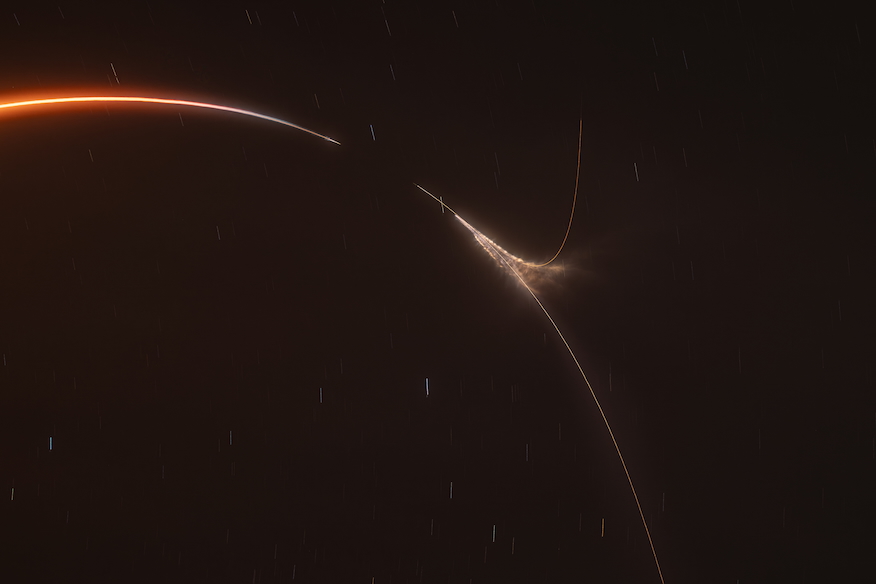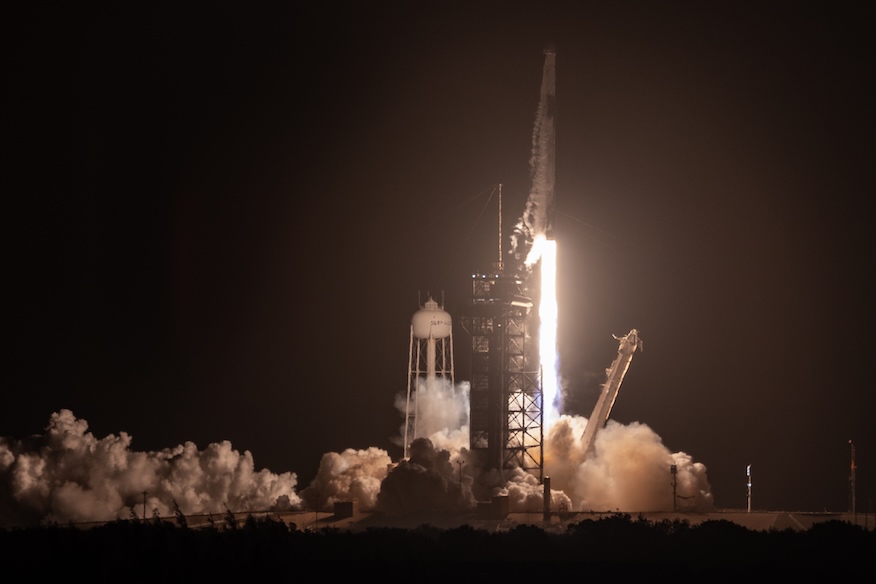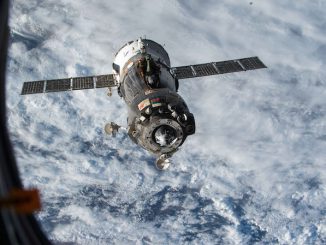
SpaceX launched an uncrewed Cargo Dragon to the International Space Station early Monday on a resupply mission with increased importance after a transportation mishap derailed a flight by another U.S. cargo ship. Liftoff from pad 39A at the Kennedy Space Center happened on Monday, April 21, at 4:15 a.m. EDT (0815 UTC).
The Cargo Dragon mission, dubbed Commercial Resupply Services 32 (CRS-32), carries 6,700 pounds (3,000 kg) of science and supplies to the station. About 9.5 minutes after launch, Dragon separated from the upper stage of the Falcon 9 rocket. Docking with the ISS forward port of the Harmony module is expected around 8:20 a.m. EDT (1220 UTC) on Tuesday, April 22. The rendezvous and docking will be overseen from inside the station by NASA astronaut Jonny Kim and Japan Aerospace Exploration Agency (JAXA) astronaut Takuya Onishi.
SpaceX did not broadcast views of the Dragon separation from the Falcon 9 upper stage, but did confirm the event. The trunk contained the STP-H10 suite of payloads for the Department of Defense’s Space Test Program, which was not noted by NASA or SpaceX prior to launch.
Earlier this year NASA replaced some science hardware on CRS-32 with food and other supplies, after the pressure vessel for the Northrop Grumman Cygnus NG-22 mission was damaged during transportation. NG-22 was already running behind schedule due to avionics problems and its original launch date had slipped from January to June 2025 before the mishap forced the cancellation of the mission altogether. The Cygnus freighter was supposed to deliver more than 8,000 lbs (3,600 kg) of cargo and supplies to the station. The next Northrop Grumman delivery mission NG-23 will not fly until September.
“We did have to reshuffle a bit of the manifest to make room for some more food and resupplies for the crew,” said Jennifer Buchli, NASA’s ISS Program Chief Scientist said at pre-launch news briefing for the Cargo Dragon mission. “However we were able to optimize our cargo on this flight and add some more investigations back in.”
Compounding the station’s resupply challenges, the introduction of a third U.S. cargo vehicle, Sierra Space’s Dream Chaser, is running more than a year behind schedule. The winged-spacecraft with its disposable cargo module, is capable of carrying 11,000 lb (5,000 kg) of pressurized cargo and 1,100 lb (500 kg) of unpressurised equipment. Zebulon Scoville, the deputy manager of the Transportation Integration Office for NASA’s ISS Program, said Dream Chaser is also now expected to fly in the Fall, along with the next generation of space station cargo ships from Japan, the HTV-X. NASA said in March it was also considering making the next flight of Boeing’s Starliner capsule a cargo-only mission.

The next Cargo Dragon, on the CRS-33 mission, is expected to launch during the summer and stay at the station for a prolonged period of time to test technologies for the U.S. Deorbit Vehicle, which is being built by SpaceX to safely bring down the ISS at the end of its planned life, around 2031.
With the Cygnus delays, CRS-33 additional thrusters will help keep the space station maintain its orbit, according to Scoville.
“There are a lot of parallels with the technologies and the hardware needed for the eventual Deorbit Vehicle, but really it’s intended to be an augmentation or a supplemental capability to ISS,” Sarah Walker, SpaceX’s Director of Dragon Mission Management, said. “It’s really just some tanks and thrusters inside our trunk. It’s a bit heavier than our typical CRS mission, but other than that, you won’t notice a ton of difference.”
Monday’s CRS-32 mission was the fifth flight for the Cargo Dragon C209, one of three cargo vehicles in SpaceX’s fleet. Its previous flights were CRS-22, 24, 27, and 30. Walker noted that the mission will debut “enhanced” drogue parachutes when the capsule makes its return to Earth in about a month.
She said they feature “stronger joints and ribbons and flipped pack to provide a smoother deployment,” which occurs about a minute prior to the deployment of the four, main parachutes.
“This is just one more way that we tangibly demonstrate that safety is our top priority,” Walker said. “There’s no current concerns with the drogue parachutes. They’ve all performed within spec and yet, we innovated a way to make them even better, so we implemented it.
“Access to such a huge volume of flight data, and the spirit for constantly making things better, allows us to refine Dragon into the best possible spacecraft for the missions that it executes.”

Walker said they NASA and SpaceX will review the data from the parachute change and “determine when to implement these improvements across the rest of the fleet as well.”
SpaceX used the Falcon 9 first stage booster 1092 for the CRS-32 mission. This was its third flight following the launches of Starlink 12-13 and NROL-69.
About 7.5 minutes after liftoff, B1092 touched down at Landing Zone 1 (LZ-1) at Cape Canaveral Space Force Station. This marked the 51st landing at LZ-1 and the 433rd booster landing to date.
The mission will mark the first orbital flight from the Eastern Range since April 14. A reason for the unusually quiet stretch has not been made public, but Sarah Walker, the director of Dragon Mission Management for SpaceX, confirmed during a prelaunch teleconference that CRS-32 had range approval for launch on Monday and their backup day, Tuesday.
Jimmy Taeger, a launch weather officer with the 45th Weather Squadron, forecast a 90-percent chance of favorable weather on both Monday and Tuesday. By Sunday this had improved to 95-percent.

What’s onboard?
The Cargo Dragon carries with it 4,780 pounds (2,168 kg) of pressurized cargo and 1,653 pounds (750 kg) of unpressurized payloads in the vehicle’s trunk.
Buchli said there are more than 30 new experiments heading up to the orbiting outpost, including multiple that are sponsored by the ISS National Laboratory and the U.S. National Science Foundation (NSF).
One such experiment comes from Rensselaer Polytechnic Institute (RPI) and Tec-Masters, which focuses protein fluid flow and clumping. They’re using the Ring-Sheared Drop module “to study protein motion and create more accurate models of the factors that lead to clumping, especially during drug manufacturing and dispensation to patients.”
“Proteins are used to make various therapies and must be concentrated in medicines to avoid needing to administer large amounts of fluid,” says Amir Hirsa, professor of mechanical, aerospace, and nuclear engineering at RPI. “But above a certain concentration, the proteins tend to form aggregates or clump.”

Another experiment highlighted by the ISS National Lab is the Aerosol Monitors investigation, which will test three different air quality monitors to learn more about which is best able to protect crews on orbit. The learning coming from the testing of these commercially available aerosol monitors have on-Earth applications, like contributing to “improvements in these devices, helping to improve public health and address climate change.”
NASA’s Biological and Physical Sciences Division also has the Advanced Plant EXperiment-12 (APEX-12) onboard. BPS said it’s designed to study space radiation on telomeres, which is the “repetitive DNA sequences that protect the ends of chromosomes, become shorter every time a cell divides and serve as markers of plant survivability.”
“This research holds significant implications since telomeres serve as vital biological markers of survivability in both plants and humans,” BPS said. “Clarifying the relationship between the space radiation environment and telomere dynamics may prove pivotal for future long-duration missions.”



